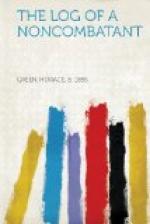During the daytime the ordinary things of life went on, for the good burghers and shopkeepers went about their business as usual, and, generally speaking, fought against fear as bravely as the soldiers in the trenches stood up against the German howitzers. It was only after dark (when martial law permitted no lights of any kind) that the city seemed to shiver and suck in its breath; doors were barricaded, iron shutters came down, and behind them the people talked in whispers. Military autos, fresh from the firing line, groaned and sputtered at the doorstep of the St. Antoine; soldiers with pocket lanterns stamped about the streets. From sheer nervousness after a day of confinement some citizens, in spite of warnings, groped about the more important avenues at night. Picture yourself on Broadway or Tremont Street, with not a light on the street gleaming from a window, and walking up and down with one hand on your wallet and the other in the pocket where your Colt automatic ought to be.
Such, very briefly, was the condition of Antwerp at the time when we arrived. That very evening word came in that the Belgian forces, which had been engaged with the enemy for five consecutive days of severe fighting, had retired behind the southern ramparts of the city.
During the night the stream of incoming wounded confirmed the news of battle. In the moonlight, and later in the gray dawn, I watched the long lines of Belgian hounds, pulling their rapid-fire guns out toward the trenches. Many times later I was destined to see them. They made a picturesque and stimulating sight—those faithful dogs of war —fettered and harnessed, their tongues hanging out as they lay patiently beneath the gun trucks awaiting the order to go into action, or, when the word had been given, trotted along the dusty roads, each pair tugging to the battle front a lean, gray engine of destruction.




